生态研究文献关键词分析对风景园林学科的启示
唐源英 曹冉 林立 祝浩翔 徐伟 王海洋
生态研究文献关键词分析对风景园林学科的启示
唐源英 曹冉 林立 祝浩翔 徐伟 王海洋
风景园林;生态学;关键词;词频分析
修回日期:2015-03-31
1 引言
随着全球城市化的加速,城市生态问题越来越受到社会的广泛关注。风景园林学中,生态方向的研究工作以维护城乡生态健康与安全为目的,研究成果应用于不同的时空尺度,如生态修复、城市绿色基础设施建设、生物多样性保护等。
《景观与城市规划》(Landscape and Urban Planning)创刊于1974年,由《景观规划》(Landscape Planning)与《城市生态》(Urban Ecology)合并而来[1]。该期刊主要收录了景观规划、景观建筑、景观保护、城市规划、景观生态、城市生态以及土地管理等研究领域的研究论文。目前,关于生态学研究进展已有多篇综述性论文发表[2-3],但在风景园林学生态研究方面,采用文献关键词分析方法报道的综述工作较少。关键词分析是文献计量的一种方法,它能快速、客观和直观地了解某个学术领域的研究,并归纳学术热点和趋势,这是一种较为直观的方法,并且在其他的学科中得到了广泛的应用[4]。

1 2004-2013文献高频关键词使用次数
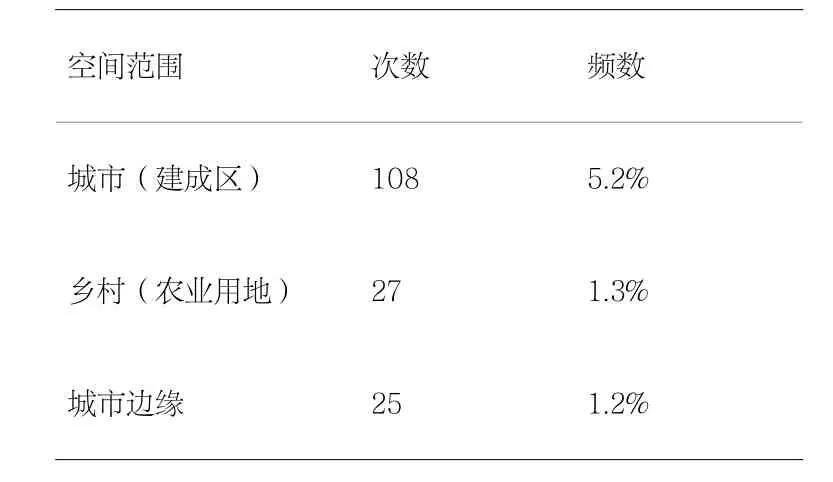
表1 2004-2013表示空间范围关键词的使用次数与词频
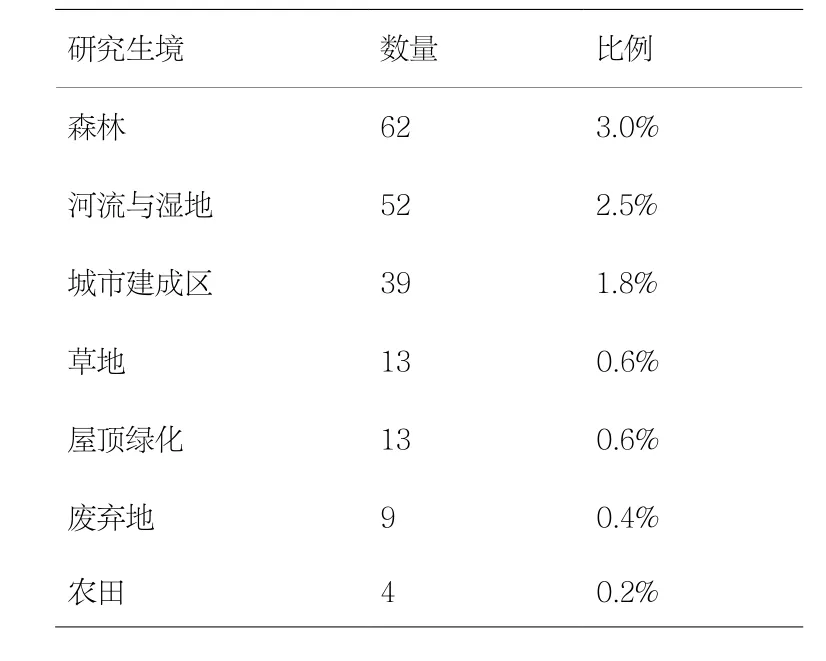
表2 2004-2013文献中关于研究生境关键词使用次数与词频
本文以《景观与城市规划》(Landscape and Urban Planning)期刊为数据源,以近10年有关风景园林学生态方面的文献为研究对象,分析文献中的关键词,分类排序,将高频词汇以及其相应的文献摘要进行总结分析,总结了近10年来风景园林生态的研究热点,探讨风景园林学生态方向的发展趋势。
2 研究方法
2.1数据源
为了分析归纳近10年国际风景园林学生态方向的研究热点和研究动向,本文以《景观与城市规划》(Landscape and Urban Planning)期刊中从2004年第66卷到2013年第120卷的54卷次为搜集范围。其中,关于风景园林学生态方向的文献有520篇。
2.2关键词分析
关键词以规范、精简的方式表达了文章的主题内容。本文共统计出2085个关键词,分别来自:(1)论文关键词部分,但去除关于研究地点等与生态研究内容关系不密切的词语;(2)题目中出现而关键词部分未出现的重要词语。
首先对关键词出现的频次进行统计。同类关键词出现的频次越高,则相关的研究成果就越多,从高频关键词的统计便可总结出近期学者们研究的焦点、热点。其次,按照研究对象、学科领域、生境类型、研究技术与方法等分类统计分析。其中,对涵义相同的相近关键词进行归并整理。最后,归纳出10个能反映风景园林科学生态研究领域的关键词,并根据其源文献摘要内容,总结研究热点。
3 对最常用关键词的研究
3.1 关键词统计
对关键词出现的频次进行统计后,提取前30个关键词(图1),其中:“土地利用(Land use)”、“生物多样性(Biodiversity)”、“保育(Conservation)” 、“城市森林(Urban forestry)”、 “城市化(Urbanization)”、“景观变化(Landscape change)”、“景观格局(Landscape pattern)”、“景观认知与偏好(Landscape perception and preference)”、“地理信息系统(GIS)”、“河流(River)”这10个关键词的次数最高,分别为98次、95次、76次、72次、66次、63次、62次、55次、50次、48次,占总关键词数的2.3%以上。
3.2依据研究对象的关键词分析
3.2.1对空间范围的研究分析
将搜集到的关键词按生态空间范围可分为3类:城市、农业用地以及城市边缘(表1)。在这3类关键词中有关“城市”的关键词出现次数较多,一共出现了108次,占所有关键词的5.2%。其主要包括“城市扩张(Urban expansion)”、“城市绿化(Urban greening)”、“城市生物多样性(Urban biodiversity)”、“城市土地覆盖(Urbanland cover)”等。而“农业用地(Agricultural land)”以及“城市边缘(Urban fringe)”出现的次数相对较小,词频分别为1.3%和1.2%,其中有关“农业用地(Agricultural land)”的研究主要在乡村土地覆盖格局的变化(梯度变化[5]、农田集约化[6])以及对农田周围生物多样的影响(斑块破碎度[7]、入侵物种[8])。而有关“城市边缘(Urban fringe)”的研究主要集中在城市扩张对城市郊区植被[5]、城乡梯度变化[9]以及郊区经济[10]的影响等。
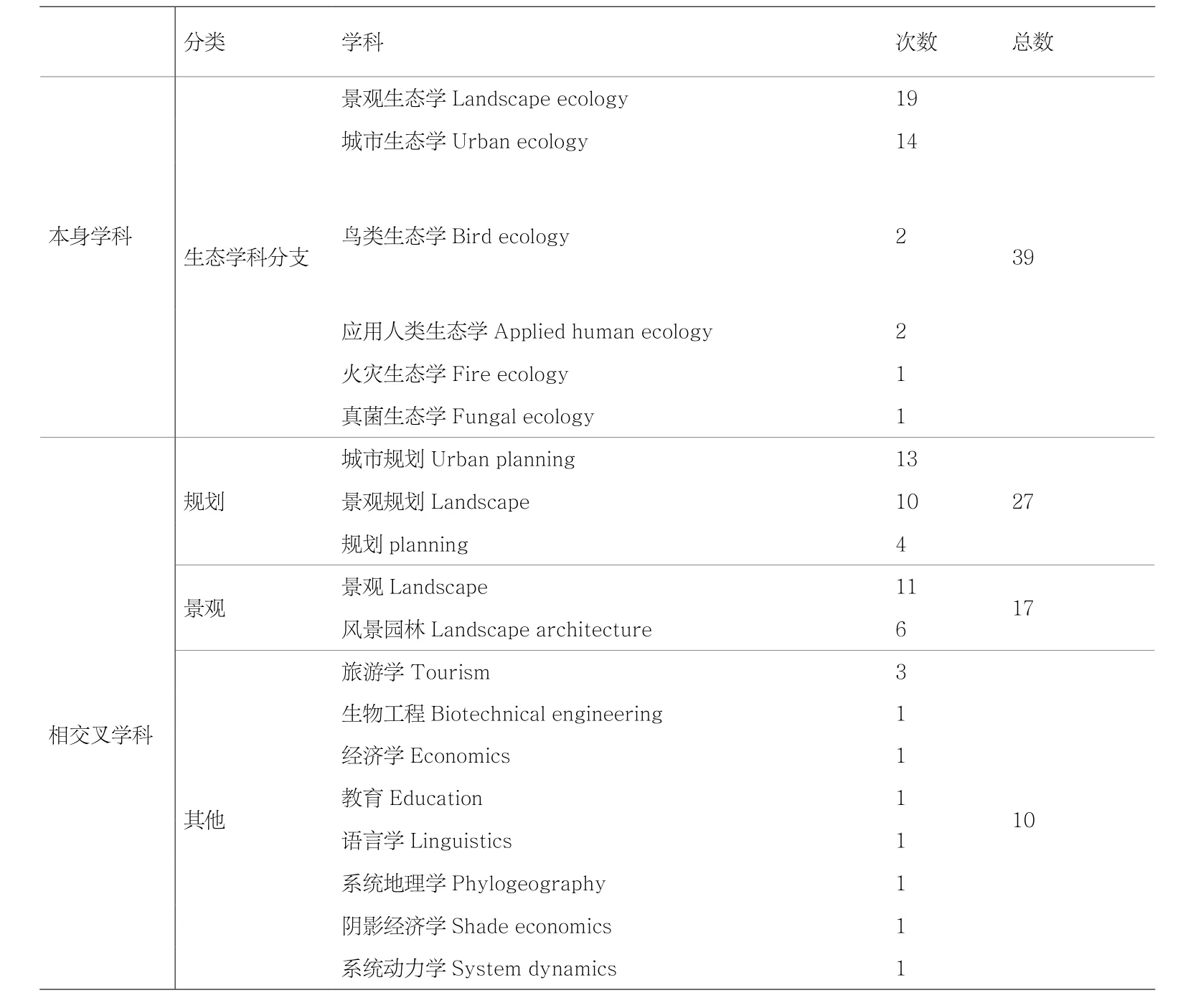
表3 关键词中关于学科使用次数

表4 2004-2013文献中关于研究方法与技术的关键词使用次数与词频
3.2.2对生境的研究分析
将搜集到的关键词按生境可分为:“森林”、“河流与湿地”、“城市建成区”、“草地”、“屋顶”、“废弃地”及“农田”(表2)。“森林”、“河流与湿地”是近10年有关生境所研究的重点,其关键词出现的次数分别为62次、52次,排名分别为第一、第二。“河流与湿地”在2008年被中国生态学家傅伯杰归纳为水域景观生态学,是近些年生态发展新的学科生长点[2];“城市建成区”主要包含了城市公园、绿道等,其出现的次数相对较少,统计其数量为39次;草地、屋顶、废弃地、农田等虽然在关键词中所占比例较低,但在近5年中出现的次数相对较多,在未来具有增长的趋势。
城市森林是城市生态系统的重要组成部分,是人类和自然系统中的宝贵资源,其在维护城市景观效益和生态系统健康中起着至关重要的作用。学者们对于城市森林的研究,一方面通过对比不同物种之间的固碳能力,分析其碳足迹,估算城市森林的长期环境效益[11-12];另一方面,由于工业经济蓬勃发展,外来常住人口的增加引发了城市森林碎片的增多,影响了城市生态系统的功能与生境的完整性。故有伊朗的学者 阿扎德(Azad Henareh)等人将扎格罗斯森林(Zagros forests)的空间格局进行量化,分析其变化的驱动因子,尤其是森林砍伐敏感性DS(deforestation sensitivity)和连通敏感性CS(connectivity sensitivity),最后将其分析的结果用于森林资源的恢复,提高城市森林的管理。也有墨西哥的学者建立了一个与森林有关的景观规划体系,用于研究城市森林的生物多样性保护、森林生态功能以及城市森林对人类的影响等[13-15]。
对于不断发展的城市来说,河流水质不断恶化,洪灾严重,河岸林带也受到了城市化和土地利用变化的威胁。中国生态学者傅伯杰总结国外文献提出,通过生态学方法可以定量反映流域景观中的结构与功能关系,比如异质性、等级性、方向性或不同空间尺度上的过程反馈[2]。例如:基于河岸带或居住区的植物特征,研究其植物群落特征及生态过程,分析出水质与植物之间的关系等[16-18]。
3.3依据学科的生态领域研究
3.3.1对表示生态学科领域的关键词研究
在学术论文中,第一个关键词是该文献的主要工作或内容所属的二级学科名称,通过对学科名称的统计分析有助于了解生态学与其他领域之间的联系。
从表3可以看出:除了生态学以外,景观生态学、城市生态学和城市规划出现的次数较多,分别为19次、14次和13次。但随着生态学研究的不断深入,与其他科学和实践学科之间的交叉与融合也在不断加强,比如:旅游学、经济学、语言学、地理学、动力学等对生态的研究方法、研究对象提供了更多的研究方向与技术。
3.3.2生态研究方法与技术
研究方法是进行实验过程的重要手段,生态研究的实验方法多种多样,常常有学者提出新的方法、理论体系、模型等,但在技术方面,地理信息系统以及遥感技术的运用为生态学研究提供了便利。生态研究一般是在一个相当大的区域范围内的,研究不同生态系统所组成的空间结构以及它们之间的相互关系,而地理信息系统或遥感技术可以在一定区域内进行景观综合模拟或景观格局指数的量化,以及在时间-空间格局上对一系列的生态过程进行分析。除开地理信息系统、遥感技术外,景观综合模拟、景观格局指数、问卷调查、评价、多项分析方法等也为生态学研究提供了一定的科学依据。(表4)
地理信息系统(GIS)在生态管理、生态监测、生态规划、生态服务系统评价及生态工程等领域中具有广泛的应用。其中,最为普遍的是利用地理信息系统建立模型,并对一系列的生态环境问题和生态过程进行准确的描述,比如生态系统模型(General Ecosystem Model)、农作物生长模型(EPIC、Cropsyst、DSSAT)、植物-土壤系统模拟模型(如CENTURY、DNDC)等。除此之外,也有学者通过地理信息系统的网络分析方法评估生态的服务功能,描述景观的动态变化[19-21];或是通过地理信息系统图层叠加分析植物群落,预测局部内土地利用变化过程[22];或是利用地理信息系统技术分析自然森林的潜在资源,将自然资源与景观游憩结合,将资源发挥最大效用[23]。
在生态学的研究中,景观指数常用于描述景观格局及其变化,它能将景观格局与景观过程进行定量化研究。如研究绿地的组合、配置[24]和大小[25];地表温度与绿地多样化之间的关系[26]等。目前,用于描述景观格局的景观指数很多,但很多景观指数不具有相互独立的统计性质,故有学者利用相关性系数,用以精简地描述景观格局。比如:利用多元共线性及强度相关系数来评估景观的影响程度和生境之间的联系[27]。

2 按年份统计热点关键词
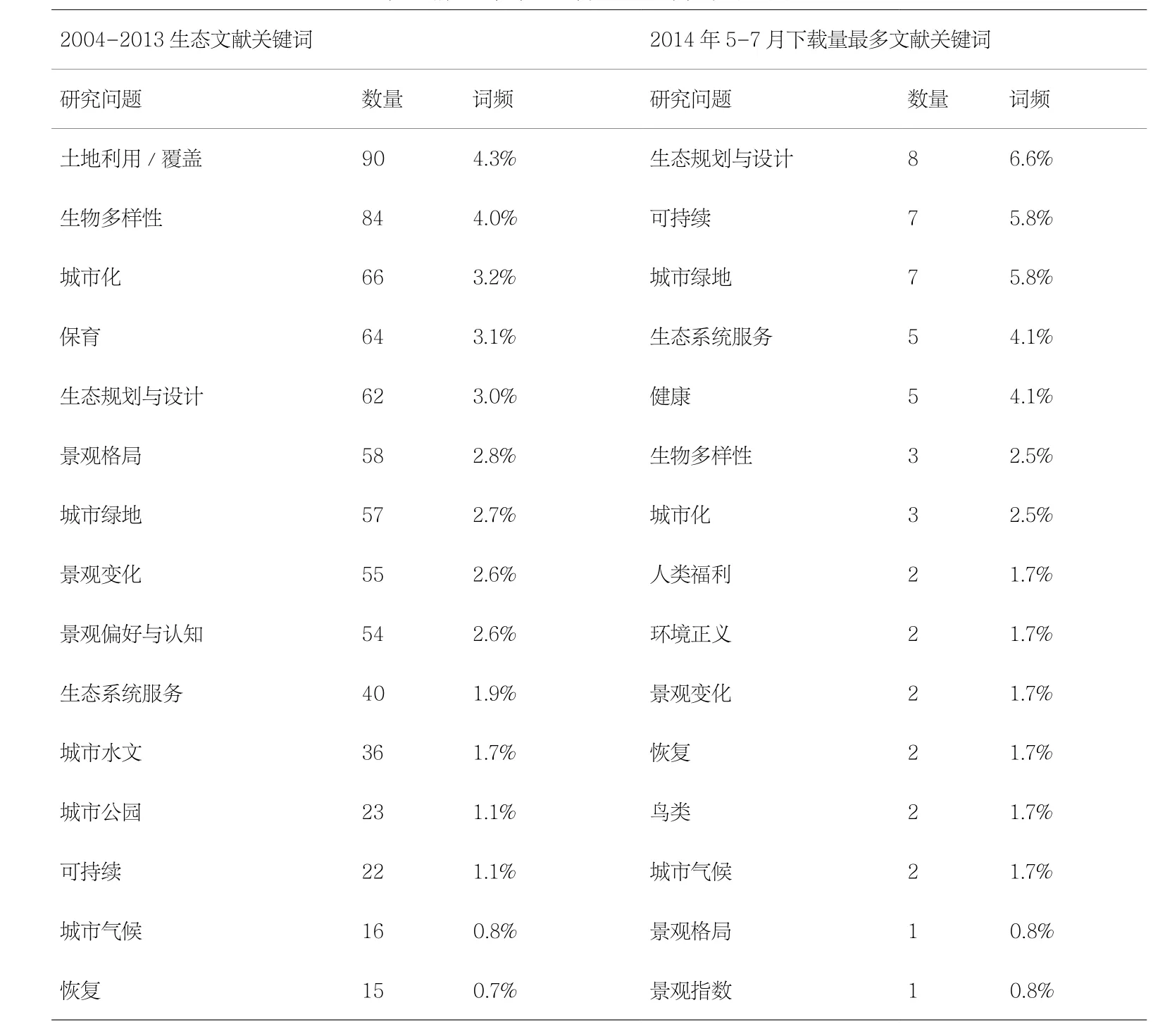
表5 前10年与近3个月的生态问题关键词对比
3.4依据生态研究热点的关键词研究
3.4.1关键词统计
本文在对2003-2013年有关生态问题的关键词进行统计的同时对2014年5-7月期刊中下载量最多文献的关键词进行统计和对比(表5):
(1)“生物多样性(Biodiversity)”、“生态系统服务(Ecosystem services)”、“城市绿地(Urban greenspace)”、“生态规划与设计(Ecological planning/design)”、“可持续(Sustainable)”、“恢复(Recovery/ Restoration)”、“城市气候(Urban climate)”在这2个方面都属于高频关键词。其中,“可持续(Sustainable)”和“城市绿地(Urban greenspace)”关键词在文献下载量的排名中属于前3位。
(2)在统计25篇下载量最多的文献关键词中可以看到,“健康(Health)”是一个新的关键词,且频数较高。在下载量最多的前25篇文献中,出现了3篇,其中包括了绿色基础设施、城市公共卫生以及城市设计等。
(3)对比两者可发现:“可持续(sustainable)”在近10年出现的次数较多,而在对近3个月的下载量统计中,“The role of urban parks for the sustainable city”这篇综述性文章在近3个月内的下载量排名一直位于第1,说明对于“可持续(sustainable)”的研究是学者们在近期内所密切关注的研究对象。
3.4.2热点研究
“土地利用/覆盖(Land use/cover)”、“城市化(Urbanization)”、“生态规划与设计(Ecological planning/design)”是城市生态研究的3大主题,但对于风景园林学科中生态问题并没有针对性。故根据风景园林学科中的生态方向总结出10类有关风景园林学科的研究热点(表6)。这10个关键词在2004-2013年的发展变化趋势总体趋势一致(图2),从2004年开始,2006-2007年中有关这10个关键词的总数达到最大,2004-2005年总数为最低。其中对于“生物多样性”、“城市水文”、“生态系统服务”、“绿地”、“保育”的研究起伏较大,而 “恢复”、“城市气候”、“健康”在这10年中大致呈增加趋势。
根据以上对热点关键词的发展变化分析后,将关键词还原到文献中,分别对其进行简要综述:
3.4.2.1生物多样性
期刊中近10年有关生物多样性的文献有很多,重点研究内容可分为2个方面:(1)生物多样性恢复。从景观的空间、生境变化、目标种以及生物量出发,研究生物多样性与生态系统稳定性的关系[28]以及综述生物多样性的潜在优势[29],用以评估城市化对生物多样性的威胁[30]等。(2)生物多样性评价。使用BIO-SAFE计算一定区域内的生物多样性,以生物多样性的指数为参照,评估景观空间分布变化,进而可得到生物多样性对区域内商业发展的潜在价值[31]。也有其他学者从评价生态系统服务的影响出发,评估土地的生产力[32];或从城市生态绿道和生态网络的连通性出发,评估城市生态建设[32]。
3.4.2.2城市水文
城市水文效应指的是城市化所引起水文过程的变化及影响,对于城市水文效应的文章大致可以分为2类:径流和水质。在径流方面,许多学者通过不同尺度的绿色屋顶[33]、不同植被类型组合以及不同的排水通道,研究对城市径流系数变化[34];在水质方面,城市化的发展对水库水质的变化有很大的影响,故有学者通过城市土壤的渗透系数、水库的形状[35]以及水库周围的土地利用变化[36]等研究来探索影响水库水质变化的原因。
3.4.2.3生态系统服务
现如今,全球大多数国家处于高度城市化状况,随之而来的便是城市绿地及城市周边绿地的损失和退化,绿地的损失和退化对生境、生态过程及生态系统服务有很大的影响。在对近10年的文献统计中,绿地生态系统服务是研究的重点,通过建立城市绿地土地利用变化模型,研究一定时期内生态系统服务的改变,并提出环境质量与经济效益之间的权衡关系[37]。而在政策方面,近些年的文献中出现了一个新的词汇——“环境正义”,它是针对自然生态规律、社会经济规律和环境规律提出的新环境资源法。在2013年有美国学者就以城市景观生态的复杂性与环境正义相结合,用以研究生态系统服务的社会生产力[38]。
3.4.2.4城市绿地
近10年中,有关城市绿地的研究一方面主要是城市绿地功能,比如:城市绿带的降噪功能[39];城市公园冷岛[40];公园小气候[41];道路网络以及城市绿地的生态系统服务功能[42]。另一方面是从城市绿地的本质出发,研究绿地的植被类型、绿地空间的破碎度、公园的步行可达性、公园的活动空间[43]等,比如:有位学者就以城市园林道路为例,探讨如何使园林道路既具有生态功能又能减少园林道路所带来的犯罪隐患[44]。
3.4.2.5保育
保育是生物及其生境多样性的管理与维护。在过去的10年里,城市化的快速发展严重影响到了居民的生活、城市的景观功能以及城市生态系统服务的维持。故在对这10年的文献中发现,有关保育的研究一方面是从建立生态网络出发,将因消耗过度而导致分散的土地联系起来,优化生物多样性保护框架,使本地物种和植物繁殖体能够得到扩散和迁移[45]。另一方面,针对生态系统服务的管理方法,有学者提出:先对区域内的社会价值观、景观丰富度、物种多样性、稀有性以及风险性进行优先级排列,然后再进行有目标的管理,最终以最大的可能性来增加生态系统服务价值[46]。
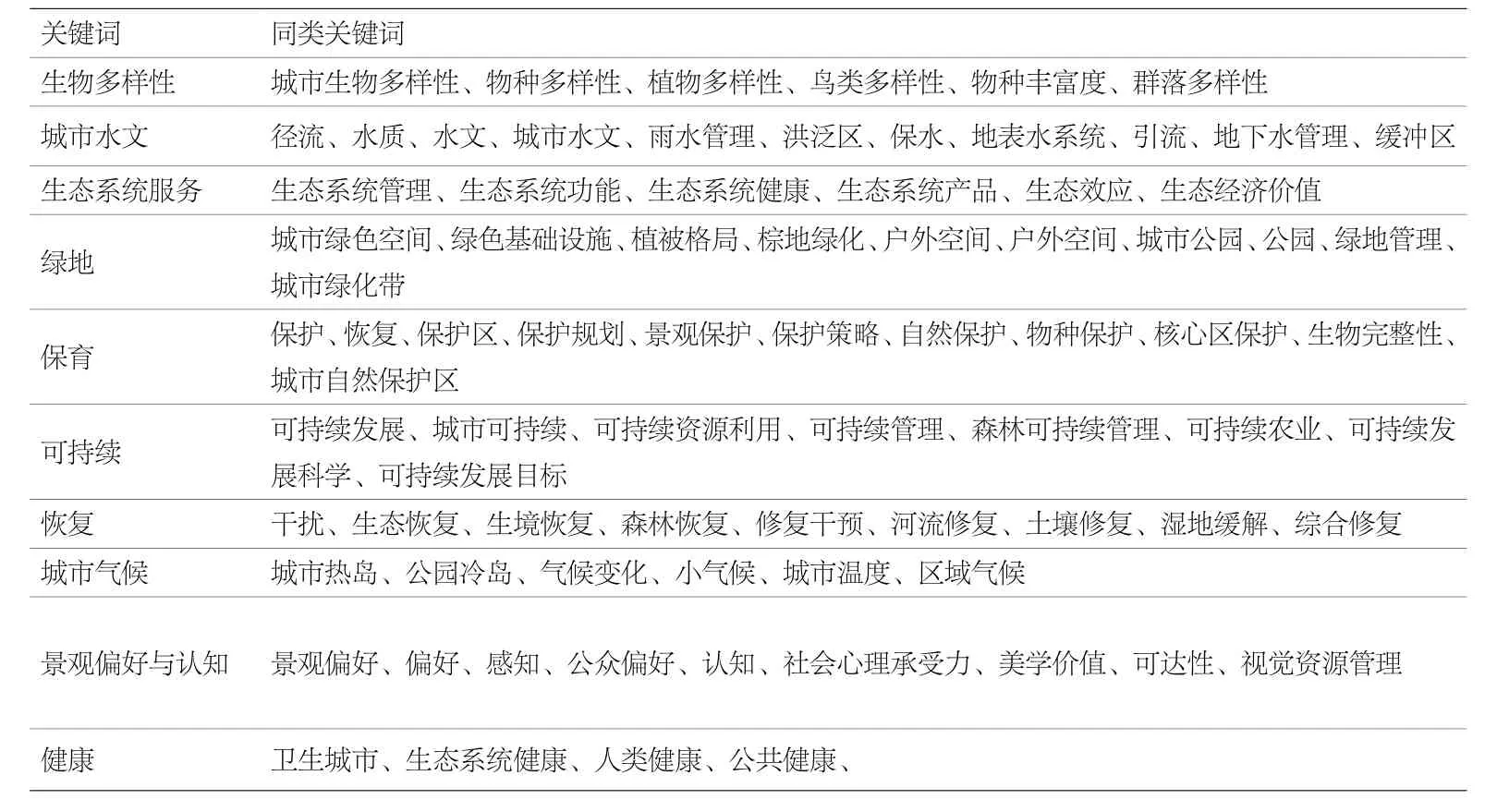
表6 研究热点关键词归类
3.4.2.6可持续
在近10年里,对于可持续发展的方法有很多,比如:①快速分类方法:一般用于洪水径流的控制和城市可持续发展能力的评价[47]。②全排列多边形综合指标法:一般用于城市资源能值消耗强度分析[48]、城市生态足迹分析以及旅游资源的管理[49]。在2013年,有学者表示:可持续发展的方法虽然有很多,但极少有人证实这些方法是否能真实反映可持续的核心目标。因此,在运用这些方法之前,我们要识别出最适合的可持续方法,使它更接近于可持续发展的核心原则。
3.4.2.7恢复
人类对土地资源无限制的使用已导致城市生物多样性的丧失和生态系统服务的下降。生态恢复就是为了扭转环境恶化,而采取一系列的人为措施。在近10年的文献研究中,关于恢复的研究对象主要包括森林资源、河岸带、湿地以及城市绿地,这些研究主要是从生物多样性的保护出发。比如森林资源的恢复:恢复的方法主要是采用植树造林的方式改善森林生物多样性和生态功能,并运用地理信息系统进行空间多准则分析和阈值分析,划分出优先领域,最后通过灵敏度来评估森林生态系统的健康性[50]。文献中也有少量的研究是以建立自然资本空间模型为基础,针对景观社会价值和生境功能,探索可持续发展背景下的多功能景观[51]。
3.4.2.8城市气候
城市热岛(Urban Heat Island)是城市气候受到城市下垫面及人类活动影响而形成的局部气候。有研究表明导致这种气候出现的原因与混凝土的增加、植被的减少、碳流量以及城市热行为有关。为了缓解城市热岛效应,学者们以城市水体、城市绿化、城市冷岛作为研究对象,探索缓解热岛效应的对策。其中,“城市绿化”已被证实能够缓解城市热岛效应,而在“城市绿化”中,化肥和除草剂的使用使城市植物物种下降,城市植被将越来越依赖于各种保护措施,导致城市植被自然生长受到了限制[53],也有其他学者研究表明土地覆盖变化和城市热岛之间具有紧密的相关性,以此说明城市热岛是可以被合理预测的[54]。此外,“城市冷岛”以公园的形式存在于城市中,它能降低一定区域内的温度,有研究结果表明,平均一个“冷岛”能降低区域温度0.94℃[55]。
3.4.2.9景观偏好与认知
不同类型的景观给人们带来的感知也不同。为了使规划与设计更好地满足人类景观需求,大多数的研究是从绿地的生态系统服务价值、景观的适宜性、景观功能以及景观的驱动力出发[56],通过问卷调查的方式进行景观偏好与认知分析。在2013年,法国学者提出了一个创新的方法论框架——景观偏好空间框架(LPSF),它能将区域内的景观偏好进行解释,将不同用户对于土地覆盖模式成分的偏好应用于土地规划[57]。
3.4.2.10健康
人类是城市环境恶化的始作俑者,而人类的健康却与城市生态息息相关,包括干净的空气、水、土壤以及社会的健康等。目前,为了缓解人类健康与人类行为之间的矛盾,有学者们通过对绿色基础设施的文献进行综述,建立城市绿地、生态系统和人类健康之间的概念框架,强调框架中的动态因素及其复杂的相互作用[58];也有学者采用绿化干预措施,如:建立公园、绿色屋顶以及植树等,通过增加城市绿化,提高生态系统服务,为人类带来健康的生活空间[55];现如今,越来越多的研究已经证明城市绿地能够改善人类的健康,比如:有学者证明娱乐空间的访问机会和与植物的接触就能给人类的心理健康带来益处[59]。
4 结论与讨论
综述结果表明,有关生态空间范围的研究主要集中在“城市”,生境研究以“城市森林”、“河流与湿地”、“城市建成区”为主。“地理信息系统”与“遥感”是最常用的研究技术,“景观指数”是景观格局与景观过程研究的常用指标,除此之外,模型的建立、问卷调查以及多向分析也是生态研究的重要手段。从总结出的风景园林学科研究热点来说,“城市森林”、“保育”、“景观格局”、“生物多样性” 、“可持续”的研究将持续成为风景园林生态所研究的重点。而在近10年中,生态学者们对于“可持续”提出的方法和理论虽然有很多,但其方法及理论的可靠性仍需要检验,如何在快速发展的城市中将“可持续”有效地运用是现如今存在的难点。
本文采用关键词分析方法对近10年的生态研究进行了综述,此综述只针对了2004 -2013年《景观与城市规划》(Landscape and Urban Planning)期刊中所刊登的文献,分析的结论还不够完善,还需要综合对其他期刊的研究,明确这10年的研究动态,为风景园林学科的未来发展提供帮助。
[1]P.H. Gobster, W.-N. Xiang. A revised aims and scope for Landscape and Urban Planning: An International Journal of Landscape Science, Planning and Design [J]. Landscape and Urban Planning, 2012, 106: 289-292.
[2]傅伯杰,吕一河,陈利项.国际景观生态学研究新进展[J].生态学报.2008, (2): 798-804.
[3]冷文芳,肖笃宁,李月辉,胡远满,贺红士.通过《Landscape Ecology》杂志看国际景观生态学研究动向[J].生态学杂志.2004, (5):140-144.
[4]Xi Jun Yu, Cho Nam Ng. Spatial and temporal dynamics of urban sprawl along two urban-rural transects: A case study of Guangzhou, China [J]. Landscape and Urban Planning, 2007, 79(1): 96-109.
[5]Montserrat Bassa, Lourdes Chamorro. Vegetation patchiness of field boundaries in the Mediterranean region:The effect of farming management and the surrounding landscape analysed at multiple spatial scales [J]. Landscape and Urban Planning, 2012, 106(1): 35-43.
[6]Anda Ruskule, Olgerts Nikodemus. The perception of abandoned farmland by local people and experts:Landscape value and perspectives on future land use [J]. Landscape and Urban Planning, 2013(115): 49-61.
[7]Francisco Artigas, Ildikó C. Pechmann. Balloon imagery verification of remotely sensed Phragmites australis expansion in an urban estuary of New Jersey, USA [J]. Landscape and Urban Planning, 2010, 95(3): 105-112.
[8]Alexander Buyantuyev, Jianguo Wu. Urbanization diversifies land surface phenology in arid environments:Interactions among vegetation, climatic variation, and land use pattern in the Phoenix metropolitan region, USA [J]. Landscape and Urban Planning, 2012, 105(1-2): 149-159.
[9]Robbert Snep, Ekko Van Ierland, Paul Opdam. Enhancing biodiversity at business sites: What are the options, and which of these do stakeholders prefer? [J]. Landscape and Urban Planning, 2009, 91(1): 26-35.
[10]Michael W. Strohbach, Dagmar Haase. Above-ground carbon storage by urban trees in Leipzig, Germany:Analysis of patterns in a European city [J]. Landscape and Urban Planning, 2012, 104(1): 95-104.
[11]E. Gregory McPherson, Qingfu Xiao. A new approach to quantify and map carbon stored, sequestered and emissions avoided by urban forests [J]. Landscape and Urban Planning, 2013(120): 70-89.
[12]Eva M. De Clercq, Lieven Clement. Monte Carlo simulation of false change in the overlay of misregistered forest vector maps [J]. Landscape and Urban Planning,2009, 91(1): 36-45.
[13]Azad Henareh Khalyani, Audrey L. Mayer. Spatial and temporal deforestation dynamics of Zagros forests(Iran) from 1972 to 2009 [J]. Landscape and Urban Planning,2013(117): 1-12.
[14]Francesco Orsi, Davide Geneletti. Identifying priority areas for Forest Landscape Restoration in Chiapas(Mexico): An operational approach combining ecological and socioeconomic criteria [J]. Landscape and Urban Planning, 2010, 94(1): 20-30.
[15]Bongghi Hong, Karin E. Limburg. Connecting the ecological-economic dots in human-dominated watersheds: Models to link socio-economic activities on the landscape to stream ecosystem health [J]. Landscape and Urban Planning, 2009, 91(2): 78-87.
[16]Michele L. Burton, Lisa J. Samuelson. Riparian woody plant traits across an urban-rural land use gradient and implications for watershed function with urbanization [J]. Landscape and Urban Planning, 2009, 91(1-2): 42-55.
[17]Elina N.M. Inkiläinen, Melissa R. McHale. The role of the residential urban forest in regulating throughfall: A case study in Raleigh, North Carolina, USA [J]. Landscape and Urban Planning, 2013(119): 91-103.
[18]Qiong Wu, Hong-qing Li. Monitoring and predicting land use change in Beijing using remote sensing and GIS[J]. Landscape and Urban Planning, 2006, 78(4): 322-333.
[19]Kyushik Oh, Seunghyun Jeong. Assessing the spatial distribution of urban parks using GIS [J]. Landscape and Urban Planning, 2007, 82(1-2): 25-32.
[20]Francesco Geri, Duccio Rocchini. Landscape metrics and topographical determinants of large-scale forest dynamics in a Mediterranean landscape [J]. Landscape and Urban Planning, 2010, 95(1-2): 46-53.
[21]Andre Zerger, Philip Gibbons. A method for predicting native vegetation condition at regional scales [J]. Landscape and Urban Planning, 2009, 91(2):65-77.
[22]Neil Bailey, John T. Lee, Stewart Thompson. Maximising the natural capital benefits of habitat creation: Spatially targeting native woodland using GIS [J]. Landscape and Urban Planning, 2006, 75(3-4); 227-243.
[23]Bunkei Matsushita, Ming Xu, Takehiko Fukushima. Characterizing the changes in landscape structure in the Lake Kasumigaura Basin, Japan using a high-quality GIS dataset [J]. Landscape and Urban Planning, 2006, 78(3):241-250.
[24]Fanhua Kong, Nobukazu Nakagoshi. Spatial-temporal gradient analysis of urban green spaces in Jinan, China [J]. Landscape and Urban Planning,2006, 78(3): 147-164.
[25]Xiaoma Li, Weiqi Zhou, Zhiyun Ouyang. Relationship
between land surface temperature and spatial pattern of greenspace: What are the effects of spatial resolution? [J]. Landscape and Urban Planning, 2013(114): 1-8.
[26]Brian G. Tavernia, J. Michael Reed. Spatial extent and habitat context influence the nature and strength of relationships between urbanization measures [J]. Landscape and Urban Planning, 2009, 92(1): 47-52.
[27]Jolande W. Termorshuizen, Paul Opdam. Incorporating ecological sustainability into landscape planning [J]. Landscape and Urban Planning, 2007, 79(3-4): 374-384.
[28]Patricia N. Manley, Sean A. Parks. Modeling urban land development as a continuum to address fine-grained habitat heterogeneity [J]. Landscape and Urban Planning,2009, 89(1-2): 28-36.
[29]Claudia Bräuniger, Sonja Knapp. Testing taxonomic and landscape surrogates for biodiversity in an urban setting [J]. Landscape and Urban Planning, 2010, 97(4): 283-295.
[30]Marta Wozniak, Rob S.E.W. Leuven Assessing landscape change and biodiversity values of the Middle Vistula river valley, Poland, using BIO-SAFE [J]. Landscape and Urban Planning, 2009,92(3-4):210-219.
[31]G.H.J. de Koning, P.C. Benítez. Modelling the impacts of payments for biodiversity conservation on regional landuse patterns [J]. Landscape and Urban Planning, 2007,83(4): 255-267.
[32]M. Margaret Bryant, C. Rhett Jacksonb. Urban landscape conservation and the role of ecological greenways at local and metropolitan scales [J]. Landscape and Urban Planning, 2006, 76(1-4): 23-44.
[33]Timothy Cartera, C. Rhett Jacksonb. Vegetated roofs for stormwater management at multiple spatial scales [J]. Landscape and Urban Planning, 2007, 80(1-2): 84-94.
[34]Marina Albertia. The impact of urban patterns on aquatic ecosystems: An empirical analysis in Puget lowland sub-basins [J]. Landscape and Urban Planning, 2007,80(4): 345-316.
[35]Soon-Jin Hwanga, Sang-Woo Leea. Moderating effects of the geometry of reservoirs on the relation between urban land use and water quality [J]. Landscape and Urban Planning, 2007, 80(4): 345-316.
[36]Sang-Woo Lee, Soon-Jin Hwang. Landscape ecological approach to the relationships of land use patterns in watersheds to water quality characteristics [J]. Landscape and Urban Planning, 2009, 92(2): 80-89.
[37]Bongghi Honga. Connecting the ecological-economic dots in human-dominated watersheds: Models to link socioeconomic activities on the landscape to stream ecosystem health [J]. Landscape and Urban Planning, 2009, 91(2): 78-87.
[38]Jennifer R. Wolch, Jason Byrne, Joshua P. Newell. Urban green space, public health, and environmental justice: The challenge of making cities ‘just green enough[J]. Landscape and Urban Planning, 2014, 125:234-244.
[39]Chih-Fang Fanga, Der-Lin Ling. Guidance for noise reduction provided by tree belts [J]. Landscape and Urban Planning, 2005, 75(1):29-34.
[40]Chi-Ru Changa, Ming-Huang Lib, Shyh-Dean Changc. A preliminary study on the local cool-island intensity of Taipei city parks [J]. Landscape and Urban Planning, 2007,80(4):386-395.
[41]Sanda Lenzholzer, Immersed in microclimatic space:Microclimate experience and perception of spatial configurations in Dutch squares [J]. Landscape and Urban Planning, 2010, 95(1-2):1-15.
[42]Kiat W. Tan. A greenway network for Singapore [J]. Landscape and Urban Planning, 2006, 76(1-4):45-66.
[43]Felix Kienast. GIS-assisted mapping of landscape suitability for nearby recreation [J]. Landscape and Urban Planning, 2012, 105(4):385-399.
[44]Makoto Yokohari. The history and future directions of greenways in Japanese New Towns [J]. Landscape and Urban Planning, 2006, 76(1-4): 210-222.
[45]Ted Weber, Anne Sloan, John Wolf. Maryland's Green Infrastructure Assessment: Development of a comprehensive approach to land conservation [J]. Landscape and Urban Planning, 2006, 77(1-2): 94-110.
[46]Brett A. Bryan, Christopher M. Raymond. Targeting the management of ecosystem services based on social values: Where, what, and how? [J]. Landscape and Urban Planning, 2010, 97(2): 111-122.
[47]Miklas Scholz. Classification methodology for Sustainable Flood Retention Basins [J]. Landscape and Urban Planning, 2007, 81(3): 27-36.
[48]Feng Lia. Measurement indicators and an evaluation approach for assessing urban sustainable development:A case study for China's Jining City. [J]. Landscape and Urban Planning, 2009, 90(3-4): 134-142.
[49]Dan Hua,Shu-li Huangb,Qiang Fenga. Relationships between rapid urban development and the appropriation of ecosystems in Jiangyin City, Eastern China [J]. Landscape and Urban Planning, 2008, 87(3): 180-191.
[50]Francesco Orsi. Identifying priority areas for Forest Landscape Restoration in Chiapas (Mexico): An operational approach combining ecological and socioeconomic criteria[J]. Landscape and Urban Planning, 2010, 94(1): 20-30.
[51]Roy Haines-Young. Modelling natural capital: The case of landscape restoration on the South Downs, England [J]. Landscape and Urban Planning, 2006, 75(3-4): 244-264.
[52]Thomas Gregor. Drivers of floristic change in large cities - A case study of Frankfurt/Main (Germany) [J]. Landscape and Urban Planning, 2012, 104(2): 230-237.
[53]Diana E. Bowler. Urban greening to cool towns and cities: A systematic review of the empirical evidence [J]. Landscape and Urban Planning, 2010, 97(3): 147-155.
[54]Li Tian. How has Shenzhen been heated up during the rapid urban build-up process? [J]. Landscape and Urban Planning, 2013, 115: 18-29.
[55]Diana E. Bowler. Urban greening to cool towns and cities: A systematic review of the empirical evidence [J]. Landscape and Urban Planning, 2010, 97(3): 147-155.
[56]Roberta Aretano, Irene Petrosillo. People perception of landscape change effects on ecosystem services in small Mediterranean islands: A combination of subjective and objective assessments [J]. Landscape and Urban Planning,2013, 112: 63-73.
[57]Sónia Carvalho Ribeiro, Antonello Migliozzi. Placing land cover pattern preferences on the map: Bridging methodological approaches of landscape preference surveys and spatial pattern analysis [J]. Landscape and Urban Planning, 2013, 114: 53-68.
[58]Konstantinos Tzoulasa, Kalevi Korpelab. Promoting ecosystem and human health in urban areas using Green Infrastructure: A literature review [J]. Landscape and Urban Planning, 2007, 81(3): 168-178.
[59]Kate Lachowycz. Towards a better understanding of the relationship between greenspace and health: Development of a theoretical framework [J]. Landscape and Urban Planning, 2013, 118: 62-69.
Inspiration of the Keywords Analysis on Ecological Study for Landscape and Architecture
TANG Yuan-ying CAO Ran LIN Li ZHU Hao-xiang XU Wei WANG Hai-yang
The keywords analysis is a statistical method of document. It can rapidly, objectively and directly show the research focus and trends of a certain academic sector. As people are increasingly paying attention to the natural environment, research of ecology has been gradually changed from purely rural nature to urban nature. This essay collects the literature on the ecology of landscape architecture published on Landscape and Urban Planning from 2004 to 2013 to make statistics and classification of the keywords according to their research object, methods and hot topics. On the basis of the abstracts of the literature, this essay summarizes the ecological research of landscape architecture profession and the hot topics in the most recent decade to estimate the development trend of the landscape architecture profession in the future.
Landscape Architecture; Ecology; Keywords; Word Frequency Analysis
TU986
A
1673-1530(2015)04-0102-09
10.14085/j.fjyl.2015.04.0102.09
2014-10-15
唐源英 /1991 年生 / 女 / 西南大学园艺园林学院风景园林学硕士(重庆 404100)
曹冉 /1990 年生 / 女 / 西南大学园艺园林学院风景园林学硕士(重庆 404100)
林立 /1991 年生 / 男 / 西南大学园艺园林学院风景园林学硕士(重庆 404100)
祝浩翔 /1989 年生 / 男 / 西南大学园艺园林学院风景园林学硕士(重庆 404100)
徐伟 /1990 年生 / 男 / 西南大学园艺园林学院风景园林学硕士(重庆 404100)
王海洋 /1964 年生 / 男 / 西南大学园艺园林学院风景园林学教授 / 硕士生导师(重庆 404100)

